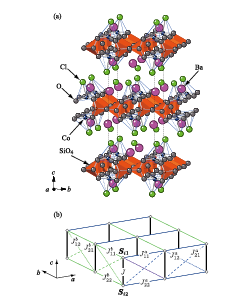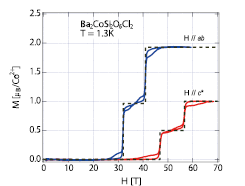Almost Perfect Frustration in the Dimer Magnet Ba2CoSi2O6Cl2
H. Tanaka and K. Kindo
Coupled spin dimer magnets provide a stage to embody the quantum physics of interacting lattice bosons. These magnets often exhibit a gapped singlet ground state. In an external magnetic field exceeding the energy gap, the Sz = +1 component of the spin triplet is created on the dimer. The Sz = +1 component, called a magnon, acts as a boson on the dimer lattice. The number of magnons can be tuned via the external magnetic field corresponding to the chemical potential. Magnons move to neighboring dimers and interact with one another owing to the transverse and longitudinal components of the interdimer exchange interactions, respectively. When the hopping term is dominant, magnons can undergo Bose–Einstein condensation while when the hopping term is suppressed so that the repulsive interaction due to the antiferromagnetic interdimer interaction is dominant, magnons can crystallize to form a regular array.

Fig. 1. (a) Perspective view of the crystal structure of Ba2CoSi2O6Cl2. Dotted lines denote the chemical unit cell. A magnetic Co2+ ion is located approximately at the center of the base of the CoO4Cl pyramid, where the pyramids are linked via orange-colored SiO4 tetrahedra in the ab plane. (b) Model of the exchange network for Ba2CoSi2O6Cl2. Thick solid lines represent the intradimer exchange interaction J, and thin solid, dashed and dotted lines represent the interdimer exchange interactions

Fig. 2. Magnetization curves measured at 1.3K for H || c* and H || ab using a piece of single crystal corrected for Van Vleck paramagnetism. Dashed lines are theoretical magnetization curves calculated using the anisotropy of the interdimer exchange interaction and the intradimer exchange interaction.
Here we report the crystal structure of the spin dimer magnet Ba2CoSi2O6Cl2 and show that this compound exhibits magnon crystallization in a high magnetic field owing to the strong frustration of interdimer exchange interactions, which is different from the orthogonal dimer model [1]. The crystal structure consists of CoO4Cl pyramids with a Cl- ion at the apex, as shown in Fig 1(a). Magnetic Co2+ is located approximately at the center of the base composed of O2-, which is approximately parallel to the ab-plane. Two CoO4Cl pyramids form a chemical dimer with their bases facing each other. The magnetic property of Co2+ in an octahedral environment is determined by the lowest orbital triplet 4T1. This orbital triplet splits into six Kramers doublets owing to spin–orbit coupling and the low-symmetric crystal field. When the temperature T is much lower than the magnitude of the spin–orbit coupling constant, the magnetic property is determined by the lowest Kramers doublet, and the effective magnetic moment of Co2+ is represented by the fictitious spin-1/2 operator [2, 3].
Figure 2 shows the magnetization curves for Ba2CoSi2O6Cl2 single crystal measured at 1.3 K for H || c* and H || ab. The entire magnetization process was observed up to a magnetic field of 70 T. The saturation of the Co2+ spin occurs at Hs ≃57 and 41 T for H || c* and H || ab, respectively. It can be clearly seen that the magnetization processes for both field directions are stepwise with a plateau at Ms/2. The singlet ground state is stabilized in a wide field range below Hc. These magnetization processes can be explained to consider that the interdimer exchange interactions are perfectly frustrated, which corresponds to the case Jab11 + Jab22 = Jab12 + Jab21 within the exchange network shown in Fig. 1(b). In this case, the magnon cannot move onto the neighboring dimer, because the hopping amplitude is proportional to Jab11 + Jab22 - Jab12 - Jab21. Hence, the ground state is determined by the balance between the Zeeman energy and the repulsive interaction between magnons. Consequently, a stepwise magnetization process with the Ms/2 plateau occurs, as observed in Ba2CoSi2O6Cl2.
In conclusion, this compound should be described as a 2D coupled spin dimer system with XY-like exchange interactions. Ba2CoSi2O6Cl2 exhibits a stepwise magnetization process with an Ms/2 plateau, irrespective of the magnetic field directions. This finding shows that the frustration for the interdimer exchange interactions is almost perfect. The Ms/2 plateau state is almost exactly given by the alternate product of singlet and triplet dimers, which corresponds to a Wigner crystal of magnons.
References
- [1] H. Tanaka, N. Kurita, M. Okada, E. Kunihiro, Y. Shirata, K. Fujii, H. Uekusa, A. Matsuo, K. Kindo, and H. Nojiri, J. Phys. Soc. Jpn. 83, 103701 (2014).
- [2] A. Abragam and M. H. L Pryce, Proc. R. Soc. London, Ser. A 206, 173 (1951)
- [3] M. E. Lines, Phys. Rev. 131, 546 (1963)
